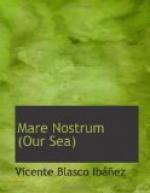Some of the transports had reached Salonica most miraculously. Their crews would relate with the fatalistic serenity of men of the sea how the torpedo had passed at a short distance from their hulls. A damaged steamer lay on its side, with only the keel submerged, all its red exterior exposed to the air; on its water-line there had opened a breach, angular in outline. Upon looking from the deck into the depths of its hold filled with water, there might be seen a great gash in its side like the mouth of a luminous cavern.
Ferragut, while his boat was discharging its cargo under Toni’s supervision, passed his days ashore, visiting the city.
From the very first moment he was attracted by the narrow lanes of the Turkish quarters—their white houses with protruding balconies covered with latticed blinds like cages painted red; the little mosques with their patios of cypresses and fountains of melancholy tinkling; the tombs of Mohammedan dervishes in kiosks which block the streets under the pale reflection of a lamp; the women veiled with their black firadjes; and the old men who, silent and thoughtful under their scarlet caps, pass along swaying to the staggering of the ass on which they are mounted.
The great Roman way between Rome and Byzantium, the ancient road of the blue flagstones, passed through a street of modern Salonica. Still a part of its pavement remained and appeared gloriously obstructed by an arch of triumph near whose weatherbeaten stone base were working barefooted bootblacks wearing the scarlet fez.
An endless variety of uniforms filed through the streets, and this diversity in attire as well as the ethnical difference in the men who wore it was very noticeable. The soldiers of France and the British Isles touched elbows with the foreign troops. The allied governments had sent out a call to the professional combatants and volunteers of their colonies. The black sharpshooters from the center of Africa showed their smiling teeth of marble to the bronze giants with huge white turbans who had come from India. The hunters from the glacial plains of Canada were fraternizing with the volunteers from Australia and New Zealand.
The cataclysm of the world war had dragged mankind from the antipodes to this drowsy little corner of Greece where were again repeated the invasions of remote centuries which had made ancient Thessalonica bow to the conquest of Bulgarians, Byzantians, Saracens, and Turks.
The crews of the battleships in the roadstead had just added to this medley of uniforms the monotonous note of their midnight blue, almost like that of all the navies of the world.... And to the military amalgamation was also added the picturesque variety of civil dress,—the hybrid character of the neighborhood of Salonica, composed of various races and religions that were mingled together without confusing their individuality. Files of black tunics and hats with brimless crowns passed through the streets, near the Catholic priests or the rabbis with their long, loose gowns. In the outskirts might be seen men almost naked, with no other clothing than a sheep-skin tunic, guiding flocks of pigs, just like the shepherds in the Odyssey. Dervishes, with their aspect of dementia, chanted motionless in a crossway, enveloped in clouds of flies, awaiting the aid of the good believers.




